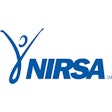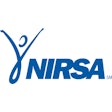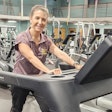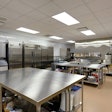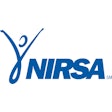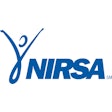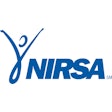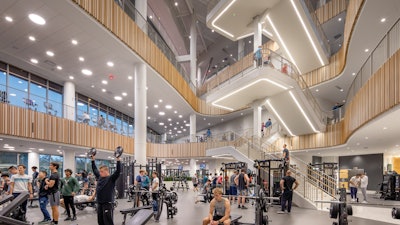
Designing, opening and maintaining a campus recreation center in the post-COVID era carries with it the responsibility of balancing the facility’s cleanability and overall maintenance with several other key priorities.
“The maintenance of the building is always balanced with the overall durability and lifespan of a product or element, the performance of that product or element, its aesthetics and its cost,” says Adam Bastjan, a designer at Milwaukee-based architecture firm Kahler Slater. “And what we see are varying levels of priority, depending on who we’re speaking with. It’s our job to balance those priorities and make sure that everybody is heard and understood — department heads, fitness directors, custodial supervisors. Because there are many scenarios in which the cleanability of a product, such as resilient carpeting, actually saves substantial dollars and time once the facility is open. So just because the initial cost of an element might be maximized, it also might be more durable, perform better and be easier to clean. That could save substantial dollars over the life of that product.”
Kahler Slater, along with Kansas City, Mo.-based HOK, designed the Bakke Recreation & Wellbeing Center, which opened in April 2023 at the University of Wisconsin. The 271,000-square-foot, four-story building is overseen by a nine-person maintenance staff, though it could use about five more staffers, according to custodial services superintendent Lazaro Garza.
The thinly spread team (administrative policies have prevented additional hires) makes it difficult to consistently maintain a clean and safe environment for students and employees — one that’s as appealing as it was on Day One. To succeed, the team employs effective policies and procedures, uses sustainable and long-lasting cleaning and disinfecting products, and creates a culture that emphasizes cleanliness and health — not only in the activities that take place within the building, but also in how the building is maintained on a daily basis.
“You need to trust your people to do the right thing,” says Garza, a former custodian who oversees custodial services at Bakke and two other sports and recreation facilities on the UW campus in Madison. “Create a culture that allows people to take pride in their work and provides feedback all the time — feedback from you and from your staff. Sometimes, your staff are the ones who find new ways to do things.”
Schedule-setting
At the core of keeping a campus recreation center (or, for that matter, any fitness or recreation facility) consistently clean is a combination of smart staff scheduling and continually encouraging users to clean up after themselves by wiping down their machines. Maintenance staff, Bastjan adds, also should be diligent in wiping down door handles, elevator buttons and other high-touch areas.
But that’s just, ahem, scratching the surface. At Bakke, Garza divides the building into sections and schedules crews to clean certain spaces at certain times.
“We realize that to clean the building without interrupting any members who are using it, overnight is the perfect time,” he says. “Nobody’s here, and we could have people who start from top to bottom and clean everything. However, it’s hard for everyone to work at night. So we said, ‘Okay, what are the most important areas we need to clean before 6 a.m.?’ We started a shift from 4 in the morning to noon that is in charge of the locker rooms, the pool area and administrative offices. If we need to do any deep cleaning, the perfect time to do that is between 4 and 6 in the morning.”
The next wave of custodians comes in for the 7 a.m. to 3 p.m. shift and maintains areas the early morning crew deep-cleaned, plus common areas, unisex restrooms and other spaces. After 3 p.m., the operations staff takes over basic custodial duties. Employees are trained on how to handle maintenance emergencies such as cleaning up blood or vomit, Garza says.
On weekends — Friday nights and from 8 a.m. to 8 p.m. on both Saturdays and Sundays — student staffers keep Bakke clean. “We train them to do the major cleaning, which is in the restrooms and locker rooms,” Garza says. “They wipe down the shower walls, make sure there’s no hair on the floor by the toilets, the urinals and the sinks. If they have a chance, they should use one of our machines to disinfect the floors.”
That approach, which has been in place pretty much since the day Bakke opened, has proven effective, he says. And inspections help ensure staff and student crews alike don’t waver in their duties. Garza, or his custodial supervisor, conducts regular inspections based on cleaning templates. For example, shower walls should have no soap scum, yellowing or mold. The underside of toilet seats and other high-use areas also should be free of discoloration.
“When I see mold, yellowing or buildup, I normally take pictures,” Garza says. “I tell my staff that the inspections are for us to get better, to show them there are some areas that they need to pay more attention to in order to avoid bigger problems later on.”

Sustainable strategies
The increasing emphasis on sustainable design has, over the years, led to the proliferation of environmentally friendly materials and cleaning products that have additional aesthetic, performance, durability and maintenance benefits.
“We have a lot of clients who are very focused on understanding exactly what products we’re putting into their facilities,” Bastjan says. “Post-pandemic, they want to know if there are materials that could help them in their efforts to not only keep things clean but keep things safe for everyone involved. It’s not something we talk about early on in the process, but as we dig deeper into the details, it absolutely becomes a priority.”
One product category in which easy maintenance, aesthetics, performance, durability and sustainability can be combined is flooring surfaces, particularly in fitness areas. J+J Flooring’s resilient and non-slip Kinetex, for example, has emerged as an alternative to traditional rubber flooring, according to Bastjan. Made of abrasion- and unravel-resistant knitted fabric, the top layer is thermally fused to a cushioned polyester felt backing. It does not absorb moisture and can be easily mopped while also containing at least 45% post-consumer recycled content, J+J Flooring says. It also boasts a 50% lower environmental impact compared to other commercial floorings.
“It’s like a rubber flooring product, but it allows for more variation in the design,” Bastjan says, adding that other manufacturers make similar flooring. “It also has acoustic properties and helps with overall noise levels, plus it’s just inherently a softer product, especially when you get people who are stretching. We’re seeing more and more of this kind of product in fitness centers.”
During the pandemic, he adds, there was heightened interest in using metals such as copper and brass that act as natural disinfectants on doorknobs and other high-touch areas like elevator buttons and railings.
At Bakke, the use of sustainable cleaning and disinfecting products has become standard operating procedure. Before landing in UW’s Recreation and Wellbeing department, Garza worked in University Housing, where custodial crews work with a solution that combines oxygen that is turned into ozone and then infused into cold tap water to attack dirt, germs, bacteria, viruses and other surface contaminants. The process uses considerably less water and chemicals than other solutions and reportedly has a high return on investment.
Garza incorporated that technology into protocol at Bakke, where it is accessed via a wall-mounted dispenser that produces the aqueous solution on demand. “As custodians, we use it to sanitize locker rooms, multipurpose rooms and other spaces and touchpoints,” he says, adding that users of fitness equipment are encouraged to wipe down their machines after each use with a different mixture of sustainable chemicals.
This fall, Garza hoped to experiment with other sustainable cleaning and sanitizing solutions that incorporate water, electricity and salt to produce a sodium hydroxide cleaner/degreaser and a hypochlorous acid disinfectant/sanitizer. Both can be produced on demand, onsite and in ready-to-use concentrations, and they are reportedly just as effective as harsh chemicals.
“Some people don’t like the smell of bleach or are allergic to it,” Garza says, recalling his days in University Housing. “So we were always trying to find products that can be more sustainable but also not harm the staff. Sometimes, even though they wore a mask, the bleach smell would get in their nose and give them headaches. Or they’d get rashes or sick. When I came over to Rec Well, the department was already using something similar. We’ve expanded our use of those types of products and have safe and happy employees.”

Finding the balance
As a designer of campus recreation facilities, Bastjan must put himself into the shoes of custodial workers and consider design strategies that can simplify their jobs, keep them safe and help them be more effective.
“I think about cleaning a house or cleaning a car,” he says. “The more edges, the more corners and crevices and things like that, the harder it is to clean. Smooth and consistent surfaces are easier.”
One of the best and most tangible examples, he adds, is tile — specifically large-format tile versus mosaic tile. In spaces with mosaic tile, such as locker rooms, dirt collects along the edges and in grout to reveal movement patterns. Those tiles are much more difficult to keep clean. Larger tiles, on the other hand, offer both built-in slip resistance and enhanced cleanability while not always sacrificing aesthetic appeal.
Ultimately, Bastjan says, “when you think about the cleanability of things, part of that is based on health and preventing the spread of viruses, and the other part is making sure that whatever you’re putting in your facility is just easier to clean.”
That gets back to key factors that influence campus recreation center design decisions — durability, performance, aesthetics, cost and cleanability. In recent years, he says, the emphasis stakeholders have placed on cleanability has fluctuated.
“I would say, pre-pandemic, maintenance and cleanability was probably last in terms of priority,” Bastjan says. “Immediately post-pandemic, it was probably number two. Now, post-pandemic, I would say it might be three or four. So it’s started to work itself more into a true balance with everything else, and in my mind, this is where it needs to be. I do think it’s extremely important, and I do think that it’s really valid to think about it. But I firmly believe that design is about finding a balance between a lot of different priorities and viewpoints.”




























